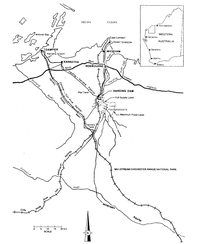


Chapter 3
I Background
II Early European Settlements
III Assessment Of Available Water Resources
IV Water Supplies For Goldmining Development
V Irrigation Development
VI Farm And Stock Water Supplies
VII Urban Water Supplies
i Reticulation systems
ii Water treatment
iii Water saving techniques
iv Desalination
v Conjunctive use - West Pilbara water supply
vi Conjunctive use - Newcastle and district water supply scheme
vii Olympic Dam mining project - water supply
viii Urban water supply dams in South Australia
ix Multi-purpose schemes - the Wivenhoe project
VIII Wastewater Management And Treatment
IX Water Quality Management
X Limnological And Water Quality Research
XI New Techniques In Water Resource Planning And Management
XII Legislation
XIII Conclusion
XIV List Of Abbreviations
XV Acknowledgements
XVI Plantations-high Productivity Resources
References
Index
Search
Help
Contact us

Conjunctive use - West Pilbara water supply
Conjunctive use of surface water and groundwater can sometimes offer an attractive and economical means of solving water supply problems where the exploitation of either resource is approaching its optimum yield. The West Pilbara scheme (Fig. 12) is a good example of innovative use of this process.
The West Pilbara region of Western Australia has developed rapidly since the mid 1960s, through the growth of the iron ore industry and, more recently, the development of the North West Shelf Gas Project. New towns have been created at inland mining centres and coastal ports. The arid climate and the deliberately high standard of urban development have resulted in high per capita water demands, approximately double those for Perth -in the order of 500 m3/person/annum, excluding industry. Initial requirements were met in 1969 by pumping from a large and unique underground source, the Millstream aquifer, through a 105 km pipeline to the coast. This system has since been extended to other coastal towns and mining settlements. The Millstream aquifer, whilst large, is not unlimited in yield, and continuous depletion could lead to deterioration of water quality and environmental damage. Planning for future demands proceeded therefore on the basis of the conjunctive use of surface water and groundwater, with surface reservoirs being used for normal demand and the aquifer being drawn down only in periods of drought. The aquifer will be recharged from reservoir releases, as well as rain, when a drought has ended.
Public interest in the scenic and recreational values of the Millstream pool area and the special significance to Aboriginals of some rivers in the region necessitated the integration of environmental and social studies with the engineering investigations over several years -an interesting combination of technology and human values.
Organisations in Australian Science at Work - CSIRO; West Pilbara Scheme, W.A.
 |
Australian Academy of Technological Sciences and Engineering |  |
© 1988 Print Edition pages 175 - 176, Online Edition 2000
Published by Australian Science and Technology Heritage Centre, using the Web Academic Resource Publisher
http://www.austehc.unimelb.edu.au/tia/178.html